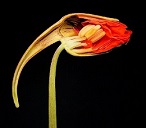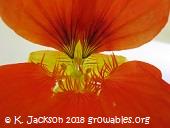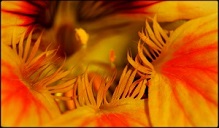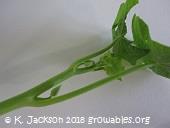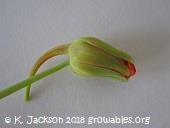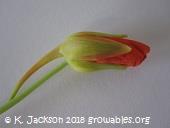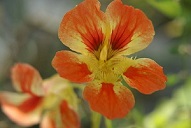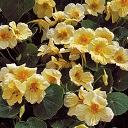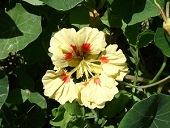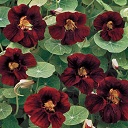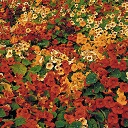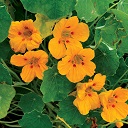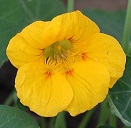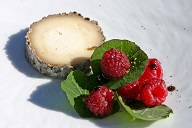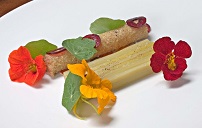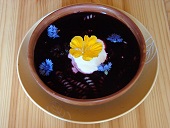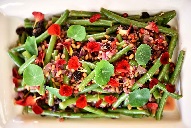| Nasturtium, Garden - Tropaeolum majus | |||||||||||||||||||||||||||||||||||||||||||||
|---|---|---|---|---|---|---|---|---|---|---|---|---|---|---|---|---|---|---|---|---|---|---|---|---|---|---|---|---|---|---|---|---|---|---|---|---|---|---|---|---|---|---|---|---|---|
 Fig. 1  Tropaeolum majus  Fig. 2  T. majus leaves 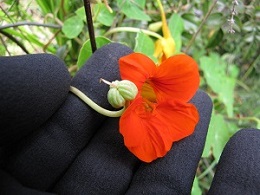 Fig. 3  Nasturtium flower and seed 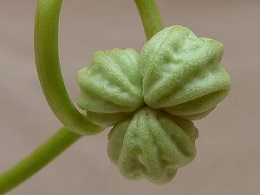 Fig. 4  T. majus seeds 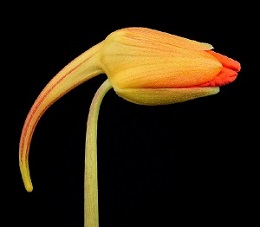 Fig. 5  T. majus, orange flower bud 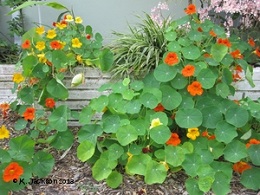 Fig. 14 Nasturtium growing in zone 10a 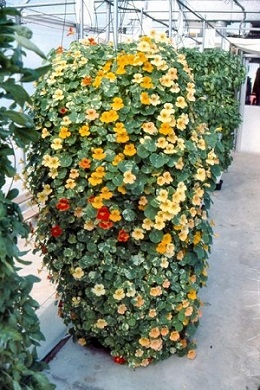 Fig. 15  Nasturtium grown as an edible flower in a vertical system 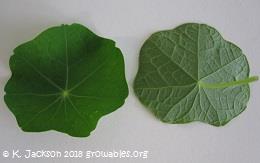 Fig. 25  Peltate: round leaf, petiole attaches near the center. Florida 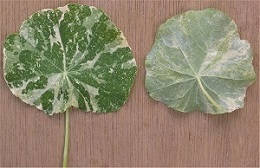 Fig. 26  T. majus variegated leaf. Holland  Fig. 27  T. majus  Fig. 29  T. majus, Botanical Garden Bremen  Fig. 30 Flowers and foliage 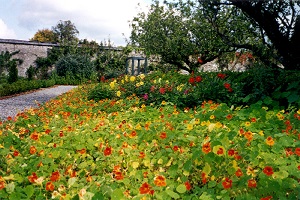 Fig. 31  Flowers in Kilkennny, Ireland  Fig. 36 Invasive. Flowering habit spreading Maui, Hawaii 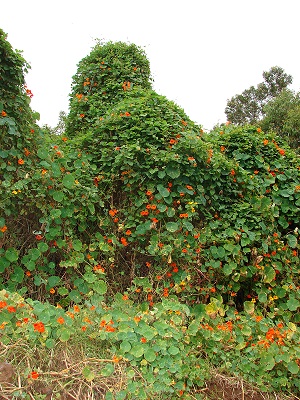 Fig. 37  Invasive. Flowering habit climbing trees, Maui, Hawaii |
Scientific
name Tropaeolum majus L. Pronunciation troe-PEE-oh-lum 14 Common names English: garden nasturtium, Indian cress, Mexican cress, nasturtium, Peruvian cress; Transcribed Chinese: han jin lian; French: cresson d'Inde, grande capucine; German: kapuzinerkresse; Hawaii: pohe haol; Maltese: kapuċinella, kabuċinella; Portuguese: chagas; Spanish: capuchina, mastuerzo; Swedish: indiankrasse 1,2 Synonyms Cardamindum majus (L.) Moench, Nasturtium indicum Garsault [Invalid], T. pinnatum Andrews, T. quinquelobum Bergius, Trophaeum majus (L.) Kuntze 11 Relatives T. minus, dwarf or bush nasturtium 1 T. tuberosum Ruiz & Pavón Family Tropaeolaceae Origin South America 13 USDA hardiness zones All 14 Uses Food, condiment, medicine, ornamental. Attracts humming birds 14 Height T. majus climber 3 ft (1 m) or longer; T. minus 1 ft (30 cm) Life form/habit Herbaceous, 14 trailing stems grow to 3 ft (1 m) or longer Life cycle T. majus: annual; T. minus: annual; T. tuberosum: perennial Leaf Peltate; round smooth and pea-green, 1 some variegated 14 Flower Yellow, orange, reddish orange, or red, sometimes striped and spotted, 2.5-6 in. (6-14 cm) long, spur 2.5-3 in. (6-8 cm) long 7 Seed pods Three segmented, about 1/3 in. (1 cm) diameter, round, ridged longitudinally Planting season Zone 9: Mar, Apr, Oct, Nov; zone 10 and 11: Nov, Dec, Jan, Feb, Mar 14 Light requirement Part shade/part sun 14 Soil texture Light sandy soils, well drained, medium to low fertility Soil depth for planting 0.5-1 in. (1-2.5 cm) deep 1 Seed spacing 2-3 in. (5-8 cm) 1 Seed germination 2 weeks 5 Cold tolerance Frost tender Drought tolerance Moderate 14 Plant spacing 12 to 18 inches apart 14 Invasive potential * Not considered invasive in Florida Disease/Pest resistance There are few pests to bother the plants 1 Reading Material Nasturtium, Garden — Tropaeolum majus L., University of Florida pdf Nasturtiums: Nature’s Nose Nabber, Eat The Weeds Origin Nasturtium is native to the South American Andes from Bolivia to Columbia. 3 Description The plant is a succulent, climbing annual. Each round smooth pea-green leaf is attached at its center to a slender round petiole. Leaves range from 2 to 5 inches in diameter. It produces numerous five-petaled yellow, orange or red flowers. These develop into round, ridged seed pods that are about 1/3-inch in diameter. 1 These should not be confused with the genus Nasturtium, which is watercress. 1 Species Nasturtium officinale. Brassiceae - Mustard family. Flowers Yellow, orange, reddish orange, or red, sometimes striped and spotted, 2.5-6 cm long, spur 2.5-3 cm long (Fig. 5), straight or curved, the lower petals deeply fringed on the claw, apex of plants usually rounded 7
Fig. 6. T. majus Bouton floral, vu en coupe lontitudinale Fig. 7. Nasturtium flower center Fig. 8. Détail de barbillons de l'entrée de la fleur. Capucine photographiée près de Lille (Nord de la France) Fig. 9. New growth Fig. 10,11,12. Bud Fig. 13. Open flower Varieties T. majus and T. minus, to name a few: Alaska: variegated leaves, Dwarf Jewel, Flame Thrower, Globe Of Fire, King Theodore: mahogany-red flowers, Moonlight: butter lemon flowers, Orange Troika, Peach Melba, Phoenix, Vesuvius, Whirlybird Gold.
Fig. 16. Empress of India, 12-14 inches tall, T. minus Fig. 17. T. majus Fig. 18. Milkmaid Nasturtium Flower 10-14 inches tall, T. majus. Closest to white of any nasturtium available to gardeners Fig. 19. Nasturtium Fig. 20. Orange and white flower Fig. 21. Black velvet, 10-12 inches tall, T. minus Fig. 22. Tip Top Nasturtium Flower, Mixture of apricot, gold, mahogany, and scarlet blossoms, 8-10 inches tall, T. majus Fig. 23. Ladybird, 8-10 inches tall, T. minus Fig. 24. Yellow flower Tropaeolum x ‘Jewel Mix’ ‘Jewel Mix’ Nasturtium, ‘Jewel Mix’ Watercress, University of Florida pdf Harvesting Harvest flowers when young. Young leaves are more succulent than those which are mature, they also have a stronger flavor than the flowers. Pods develop (Fig. 3,4) about 4 months after seeding. 1 Pick green immature seeds for pickling. Allow seeds to dry on the vine for saving to plant next season. Propagation by seed Sow the seeds about ½ to 1 inch deep, spaced 2 to 3 inches apart. When plants of the tall type are about 7 inches tall, place a stake or trellis near them for support. It is not necessary to stake or trellis the dwarf type T. minus L. The plants respond to the same general cultural practices used for most garden vegetables. They can be started indoors, although seedlings can be difficult to transplant. Allow seven to fourteen days for germination. 1
Companion Plants: Nasturtiums are also considered widely useful companion plants. They repel a great many cucurbit pests, like squash bugs, cucumber beetles, and several caterpillars. They have a similar range of benefits for brassica plants, especially broccoli and cauliflower. They also serve as a trap crop against black fly aphids. They also attract beneficial predatory insects. 8 Fertilizing Grows well in poor soils, fertilizer and excess water will generally encourage luscious leaves and less flowers. Irrigation Pests/Diseases Nematode Management for Bedding Plants, University of Florida pdf Marigolds (Tagetes spp.) for Nematode Management, University of Florida pdf Powdery Mildew on Nasturtium in South Florida, University of Florida pdf Common Weed Hosts of Insect-Transmitted Viruses of Florida Vegetable Crops, University of Florida pdf Disease Management: Tomato Spotted Wilt, University of Florida pdf (Archived) Food Uses All parts are edible. Leaves, flowers, and seed pods have a peppery taste. The flowers and young leaves are frequently used to mix in salads, and the seeds, gathered while young and green, are used for pickling and as an excellent substitute for capers. 10
Fig. 32. Charollais Fermier Raspberries, nasturtium leaves, juniper balsamic Fig. 33. Leek Terrine, Quinoa, Nasturtium Fig. 34. Blueberry soup, edible Flowers Fig. 35. Green Bean Salad, T. majus Vietnamese salad rolls recipe, Kittee's Blog, Cake Makers To The Stars. Nutritional value The flowers of T. majus are an excellent food sources of lutein and the leaves good sources of both lutein and the provitamin A β-carotene. Violaxanthin, antheraxanthin, zeaxanthin, zeinoxanthin, β-cryptoxanthin, α-carotene, and β-carotene were also detected at very low levels. 9 Medicinal Properties ** All parts of the plant, including flowers, flower buds, and leaves, are edible and contain high concentrations of bioactive metabolites, which confer several medicinal and beneficial properties. Nasturtium is a rich source of vitamin C. The leaves have high concentrations of glucotropaeolin (a glucosinolate whose break-down products have anticancer properties), and the flowers are a valuable source of anthocyanins and carotenoids. (Garzon and Wrolstad 2009; Ghedira and Goetz 2013). In the United States, although the market of nasturtium is limited to local use as a specialty crop, it is highly valued and is increasingly distributed in specialty stores and farmer’s markets as a nutraceutical food (dietary supplement). 13 T. majus L. is listed for use in herbal medicine: allergenic, antibacterial, antipyretic, antiscorbutic, antiseptic, depurative, diuretic, emmenagogue, expectorant, fungicide, laxative, rodenticide, rubefacient, stimulant, vulnerary. 4 Avoid for infants or small children and patients with gastrointestinal ulcers or kidney disease. Irritation of the mucous membrane of the gastrointestinal tract. 5 The leaves are strongly antiseptic. As an internal cleanser, this plant is of special benefit to the blood and the digestive system. 12 Invasive Status Described as weedy; quick maturing, produces many viable seeds, smothering habit and rapid growth. Tolerates salt, wind, hot to cold, semi-shade, damp, damage, and poor soil. Smothers low-growing habitats and prevents the establishment of native plant seedlings. 6 In some areas T. majus L. is listed as invasive: Australia (Pacific offshore islands) Lord Howe Island Chile (offshore islands) Juan Fernández Islands Ecuador (Galápagos Islands): Isabela Group, San Cristóbal Group, Santa Cruz Group State of Hawaii: Hawai‘i (Big) Island, Kaua‘i Island, Maui Island, Moloka‘i Island General Flowering Vines for Florida, University of Florida pdf (archived) Alternatives to Pesticides and Chemicals Hydrogen peroxide as a soil amendment for greenhouse nasturtium production (Tropaeolum majus L.) Further Reading Nasturtium Flowers ext. link Nasturtium Art Older material Nasturtium, 1919, Sturtevant’s Edible Plants Of The World Indian cress, 1853, The Book Of The Garden List of Growers and Vendors |
||||||||||||||||||||||||||||||||||||||||||||
| Bibliography 1 Stephens, James M. "Nasturtium, Garden - Tropaeolum majus L." Horticultural Sciences Dept., UF/IFAS Extension, HS632, Original Pub. May 1994, Revised Sept. 2015, reviewed Oct. 2018, AskIFAS, edis.ifas.ufl.edu. Accessed 28 July 2017, 29Dec. 2023. 2 "Tropaeolum majus L." USDA National Plant Germplasm, 2008, ars-grin.gov. Accessed 11 Dec. 2014. 3 Christman, Steve. "Tropaeolum majus L." Floridata, 2005, floridata.com. Accessed 11 Dec. 2014. 4 Duke, James A., et al. "Nasturtium (Tropaeolum majus L.)." Handbook of Medicinal Herbs, Second Edition, CRC Press, Boca Raton, Florida, 2002, p.521, www.pdfdrive.net/handbook-of-medicinal-herbs-d6646387.html. Accessed 21 Mar. 2018. 5 "Tropaeolum majus L." Plants For A Future, pfaf.org. Accessed 11 Dec. 2104. 6 "Tropaeolum majus." weedbusters.co.nz. Accessed 19 Dec. 2014. 7 "Tropaeolum majus L. Tropaeolaceae." Pacific Island Ecosystems at Risk, 2011, PIER, hear.org. Accessed 19 Dec. 2014. 8 "Tropaeolum majus." Wikipedia, the free encyclopedia, 2014, wikipedia.org. Accessed 19 Dec. 2104 9 Niizu, P. Y., and D. B. Rodriguez-Amaya. "Flowers and Leaves of Tropaeolum majus L. as Rich Sources of Lutein." Journal of Food Science, 70: S605–S609. 31 May 2006. doi: 10.1111/j.1365-2621.2005.tb08336.x, researchgate.net. Accessed 19 Dec. 2014. 10 McIntosh, C. The Book of the Garden. 2:170. Edinburgh, London, 1855. 11 "Tropaeolum Majus L." The Plant List (2013). Version 1.1. Published on the Internet; www.theplantlist.org/tpl1.1/record/kew-2522052. Accessed 1 Jan. 2015. 12 Conway, David. The Magic of Herbs. Glasgow: Collins, 1975. 13 Roberts, Pamela D., et al. "Powdery Mildew on Nasturtium in South Florida." Horticultural Sciences Dept., UF/IFAS Extension, May 2017, Reviewed June 2020, AskIFAS, edis.ifas.ufl.edu/pp335. Accessed 31 July 2017, 29 Dec. 2023. 14 Gilman, Edward F. "Tropaeolum spp." Environmental Horticulture Dept., UF/IFAS Extension, FPS-590, Original pub. October 1999, Reviewed Feb. 2014, Archived, AskIFAS, edis.ifas.ufl.edu/fp590. Accessed 10 Feb. 2018, 29Dec. 2023. Photographs Fig. 1 Jackson, Karen. "Nasturtium Series." 2013, www.growables.org. Fig. 2 Dzierżanowsk, Kajetan. Tropaeolum majus leaves. 27 Aug. 2007, (CC BY-SA 3.0), commons.wikimedia.org/wiki/File:Tropaeolum_majus_leaves.JPG. Accessed 10 Feb. 2018. Fig. 3 Forest and Kim Starr. Tropaeolum majus (Garden nasturtium). Alii Kula Lavender Farm Waipoli Rd, Maui. 2010. starrenvironmental.com. Accessed 18 Dec. 2014. Fig. 4 Jamain. Tropaeolum majus fruit, Fruit de Tropaeolum majus, (Grande capucine). 26 Aug. 2012, (CC BY-SA 3.0), commons.wikimedia.org/wiki/File:Tropaeolum_majus_fruit_J3.jpg. Accessed 10 Feb. 2018. Fig. 5 Vincentz, Frank. Tropaeolum majus, orange bud. 23 Aug. 2007, (CC BY-SA 3.0), commons.wikimedia.org/wiki/File:Tropaeolum_majus_03_ies.jpg. Accessed 10 Feb. 2018. Fig. 6 Vincentz, Frank. Tropaeolum majus Bouton floral, vu en coupe lontitudinale. 23 Aug. 2007, (CC BY-SA 3.0), commons.wikimedia.org/wiki/File:Tropaeolum_majus_03_ies.jpg. Accessed 10 Feb. 2018. Fig. 7 Jackson, Karen. Nasturtium flower center. 2018. www.growables.org. Fig. 8 Lamiot. Détail de barbillons de l'entrée de la fleur. Capucine photographiée près de Lille (Nord de la France). 24 Sep 2011, (CC BY-SA 3.0), commons.wikimedia.org/wiki/File:Tropaeolum_majusLamiot21.jpg. Accessed 10 Feb. 2018. Fig. 9 Jackson, Karen. New growth. 2018. www.growables.org. Fig. 10,11,12 Jackson, Karen. Bud series. 2018. www.growables.org. Fig. 13 Jackson, Karen. Open flower. 2018. www.growables.org. Fig. 14 Jackson, Karen. Nasturtium growing in zone 10a. 2018. www.growables.org. Fig. 15 Nasturtium grown as an edible flower in a vertical system. 2012. Alternative Greenhouse Crops - Florida Greenhouse Vegetable Production Handbook, Vol 3. University of Florida. edis.ifas.ufl.edu. Accessed 19 Dec. 2014. Fig. 16 Flower, Empress of India Nasturtium, Tropaeolum minus. Online Catalogue 2018. seedsavers.org/empress-of-india-nasturtium-flower. Accessed 16 Feb. 2018. Fig. 17 Hille, Rob. Tropaeolum majus. 20 Aug. 2011, (CC BY-SA 3.0), commons.wikimedia.org/wiki/File:Tropaeolum_RH.jpg. Accessed 10 Feb. 2018. Fig. 18 Flower, Milkmaid Nasturtium, Tropaeolum majus. Online Catalogue 2018. www.seedsavers.org/milkmaid-nasturtium-flower. Accessed 16 Feb. 2018. Fig. 19 Bernhard, Hans. (Schnobby). Nasturtium. 30 June 2004, (CC BY-SA 3.0), commons.wikimedia.org/wiki/File:Tropaeolum_majus_2004.jpg. Accessed 10 Feb. 2018. Fig. 20 Reynolds C. Orange and white flower of nasturtium, Tropaeolum majus. 2007. UC Statewide IPM Program, Regents, University of California. ipm.ucdavis.edu. Accessed 1 Jan. 2015. Fig. 21 Flower, Black Velvet Nasturtium. Tropaeolum majus. Online Catalogue 2018. www.seedsavers.org/black-velvet-nasturtium-flower. Accessed 16 Feb. 2018. Fig. 22 Flower, Tip Top Nasturtium, Tropaeolum majus. Online Catalogue 2018. www.seedsavers.org/tip-top-nasturtium-flower. Accessed 16 Feb. 2018. Fig. 23 Flower, Ladybird Nasturtium, Tropaeolum minus. Online Catalogue 2018. www.seedsavers.org/ladybird-nasturtium-flower. Accessed 16 Feb. 2018. Fig. 24 Reynolds C. Yellow flower of nasturtium, Tropaeolum majus. 2007. UC Statewide IPM Program, Regents, University of California. ipm.ucdavis.edu. Accessed 1 Jan. 2015. Fig. 25 Jackson, Karen. Peltate: round leaf, petiole attaches near the center. Florida. 2018. www.growables.org. Fig. 26 Rasba. Tropaeolum majus. 5 July 2005, (CC BY-SA 3.0), commons.wikimedia.org/File:Oostindische_kers_blad_Tropaeolum_majus.jpg. Accessed 10 Feb. 2018. Fig. 27 Vincentz, Frank. Tropaeolum majus. 25 Aug. 2007, (CC BY-SA 3.0), commons.wikimedia.org/wiki/File:Tropaeolum_majus_05_ies.jpg. Accessed 11 Feb. 2018. Fig. 28 Jackson, Karen. Seedlings. 2013. www.growables.org. Fig. 29 Tubifex. Tropaeolum majus - Botanical Garden Bremen. 9 Sep. 2009, (CC BY-SA 3.0), commons.wikimedia.org/wiki/File:3854_-_Tropaeolum_majus_(Große_Kapuzinerkresse).JPG. Accessed 11 Feb. 2018. Fig. 30 Jackson, Karen. "Nasturtium Series." 2013. www.growables.org. Fig. 31 Pixie. Flowers in Kilkennny, Ireland. 23 June 2006, (CC BY-SA 3.0), commons.wikimedia.org/wiki/File:Kilkenny_1,_Ireland.jpg. Accessed 10 Feb. 2018. Fig. 32 Talbot, H. Alexander. Charollais Fermier Raspberries, nasturtium leaves, juniper balsamic. 30 Aug. 2005, (CC BY-SA 2.0), commons.wikimedia.org/wiki/File:CharollaisFermierRaspberryNasturtiumJuniperBalsamic_(8312256180).jpg. Accessed 5 Feb. 2018. Fig. 33 Talbot, H. Alexander. Leek Terrine, Quinoa, Nasturtium. 1 Jan. 1980, (CC BY-SA 2.0), commons.wikimedia.org/wiki/File:LeeksQuinoaNasturtiumMustardCherry_(8329871862).jpg. Accessed 4 Feb. 2018. Fig. 34 Chrumps. Blueberry soup. 7 July 2013, (CC BY-SA 3.0), commons.wikimedia.org/wiki/File:Blueberry_soup.jpg. Accessed 4 Feb. 2018. Fig. 35 Waddington, Rod. Green Bean Salad, Tropaeolum majus. 12 Apr. 2015, (CC BY-SA 2.0), www.flickr.com/photos/rod_waddington/17119484051/. Accessed 4 Feb. 2018. Fig. 36 Forest and, Kim Starr. Tropaeolum majus (Garden nasturtium) Flowering Habit Spreading. Shibuya Farm Kula, Maui. 2011. starrenvironmental.com. Accessed 18 Dec. 2014. Fig. 37 Forest and, Kim Starr. Tropaeolum majus (Garden nasturtium) Flowering Habit Climbing Trees. Kula, Maui. 2009. starrenvironmental.com. Accessed 18 Dec. 2014. * UF/IFAS Assessment of Non-native Plants in Florida's Natural Areas ** The information provided above is not intended to be used as a guide for treatment of medical conditions using plants. Published 18 Dec. 2014 KJ. Last update 29 Dec. 2023 LR |
|||||||||||||||||||||||||||||||||||||||||||||
